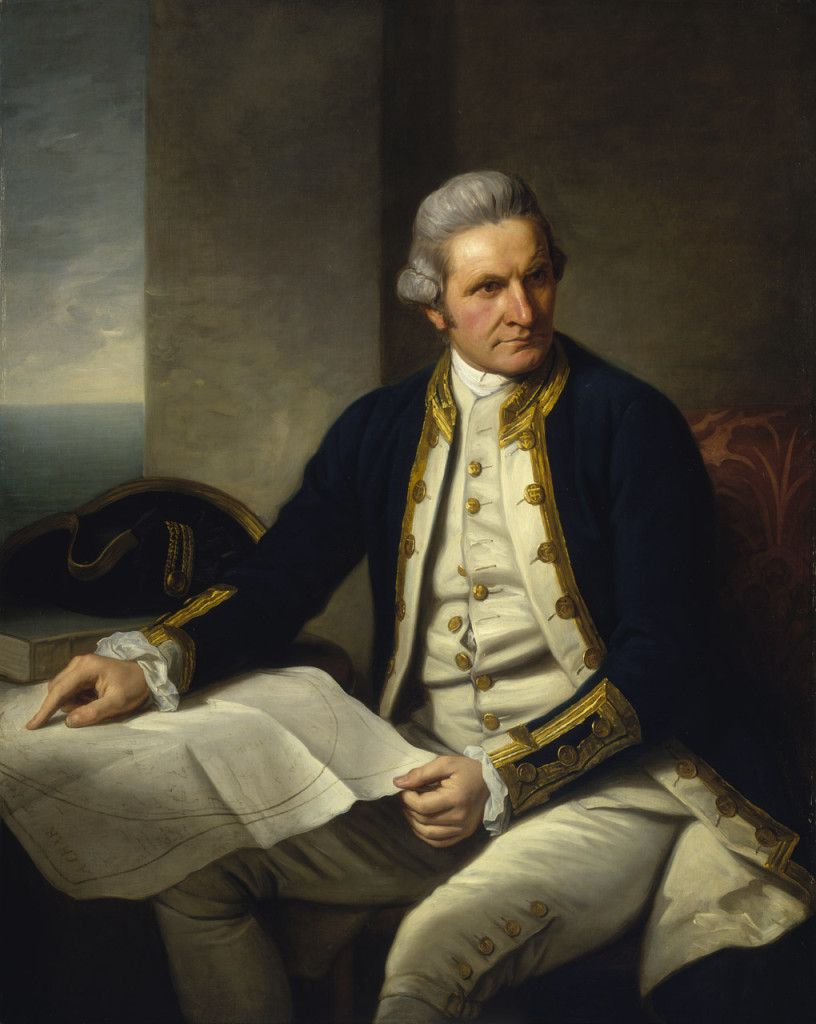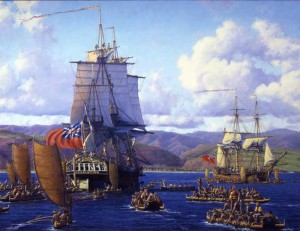by James L. Haley
Chapter 1: The Loneliness of a God – Captain Cook
After rounding the southern tip of the island, Captain Cook’s ships headed north up the western side. About thirty miles on, a small bay opened up on their right, about a mile across that bit half a mile into the coast. On the south shore lay a beach; the east side vaulted steeply up to a beetling precipice several hundred feet high that sheltered the bay from the trade winds. Its face was so inaccessible that its caves held the bones of generations of kings, and the natives called it Pali Kapu o Keoua, the Sacred Cliff of Keoua, after the dynastic founder. Then it descended on the north shore to a lava shelf just above the water, as low and flat as a wharf. Resolution and Discovery entered Kealakekua Bay and dropped anchor in seven fathoms of turquoise water.
Within moments a throng of thousands teemed on the shore, and the people raced out in their canoes to discover what manner of gods had come to visit them, and what gifts they had brought. “Cook,” wrote Ledyard, “ordered two officers into each top to number them with as much exactness as they could.” Both counts exceeded three thousand canoes in the water, with as many as six natives in each, with more thousands of people on the shore, rejoicing. Overall, Cook made a rough guess that between 350,000 and 400,000 natives inhabited the entire archipelago—a number that, interestingly, has stood as a sensible mid-range figure in a scholarly debate over the size of the pre-contact population, figures that have ranged from 200,000 to more than 1 million.

Image is in the public domain via Wikipaedia.com
But of the three thousand canoes knifing toward him, Captain Cook was not alarmed, for he knew the Polynesians to be fulsome, festive people. Women swarmed on board to give themselves to these godlike creatures; they chanted their intentions, reinforced with stunningly suggestive hula, as recorded by twenty-eight-year-old ship’s surgeon David Samwell, of the Discovery:
Where, oh where
Is the hollow-stemmed stick, where is it,
To make an arrow for the hawk?
Come and shoot.…
A penis, a penis to be enjoyed:
Don’t stand still, come gently,
That way, all will be well here,
Shoot off your arrow.
Leaving behind the mass mating on his ships, Cook was rowed ashore in his pinnace; chiefs who accompanied him motioned the crowding canoes aside with long white poles—necessary because three thousand canoes in less than one-half square mile of water, and then crowding about Cook, created an unmanageable confusion. Ashore, “as they passed through the throng, the chief cried out in their language that the great Orono [Lono] was coming, at which they all bowed and covered their faces with their hands until he was passed [sic].” To Ledyard’s consternation, Cook made a joke of the natives’ groveling: Having prostrated themselves, they rose once he went by and stared after him; then Cook would spin around and face them again, forcing them to fall to the ground once more. Cook was feted with the best that the islanders had to offer, although as a god, he could not be troubled by having to chew his own food. He was attended by chiefs, who reverently chewed the food for him and placed the masticated wads in Cook’s mouth, which he managed to swallow. Contrary to the Captain Cook cult fostered by his officers, Corporal Ledyard was mortified by what he saw, and in later years American missionaries who heard the story from old natives blamed Cook darkly for his hubris in accepting their homage as a deity, which, they declared, made him responsible for his own looming disaster.

Image is in the public domain via Expeterra.com
After preliminary contact was made, and with suitable advance preparations, Captain Cook returned the courtesy and welcomed aboard Kalaniopu‘u, the king of Hawai‘i Island, an old man, noticeably not as huge as other chiefs of his class, wizened and palsied from years of consuming ‘awa, a native hallucinogen. Among the king’s gifts to the god was an ‘ahu‘ula, a feather cloak that featured vivid geometry in red, black, and yellow; such cloaks were the epitome of the islands’ handicrafts. The king removed the cape from his own shoulders and placed it on Cook’s, then removed also his matching feathered helmet, his mahiole, and gave it as well; perhaps a half dozen more cloaks were laid at Cook’s feet, gifts of stunning value. The rarest feathers were the yellow; the bird from which they came, the ‘o‘o, was jet black, with a single yellow feather beneath each wing. Professional birdcatchers harvested the yellow feathers and released the birds to regrow them. It would have been difficult for Captain Cook to realize the wealth that was offered at his feet.
Read more about Hawaiian history by James Haley here
Accompanying Kalaniopu‘u onto the Resolution was his son and heir, Kiwala‘o, and a representative sample of the young ali‘i. The most striking of them, to British sensibilities, was the king’s nephew. A massive young man, he was variously described as from six feet four inches to seven feet in height. Heavyset and to Western eyes ugly, he was intense, brooding, with the thick, downturning mouth of the Polynesian, a low, prominently ridged brow, and heavy-lidded eyes. He was aloof, observant, his every glance seeming to be an appraisal. His name was Kamehameha, which in its full iteration meant “the Loneliness of a God.”
JAMES L. HALEY is the author of CAPTIVE PARADISE: A History of Hawaii and a critically acclaimed historian and biographer. His books have been praised by Publishers Weekly who called Passionate Nation: An Epic History of Texas “Outstanding.” USA Today called his book Wolf: The Lives of Jack London “fascinating,” and The Wall Street Journal said that Haley “surpasses Irving Stone.”
